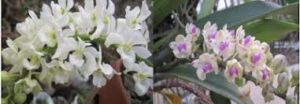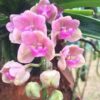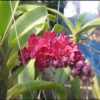Organizing an Introductory Workshop on Caring for Dendrobium Anosmum (Đai Châu Orchid) for Beginners

Dendrobium anosmum, commonly known as the Đai Châu orchid, is a stunning flower native to Southeast Asia, particularly cherished in Vietnam. Its unique beauty and fragrant blooms have made it a favorite among orchid enthusiasts and gardeners alike. However, caring for orchids can be a challenge for beginners due to their specific needs for light, humidity, temperature, and nutrition. Organizing a workshop focused on teaching beginners how to care for Dendrobium anosmum is an excellent way to share knowledge and foster a community of orchid lovers. In this comprehensive guide, we will explore how to effectively organize a workshop that equips participants with the essential skills and knowledge to care for this exquisite orchid.
## 1. Understanding the Basics of Dendrobium Anosmum Care
Before diving into the organization of the workshop, it is crucial to have a thorough understanding of the care requirements for Dendrobium anosmum. This knowledge will enable you to provide accurate and useful information to participants.
### 1.1 Overview of Dendrobium Anosmum
– **Botanical Characteristics**: Dendrobium anosmum is an epiphytic orchid known for its tall, slender pseudobulbs and clusters of fragrant flowers that bloom in shades of purple and lavender.
– **Habitat**: Native to tropical regions, this orchid thrives in humid environments with bright, indirect light.
– **Growth Cycle**: Understanding the growth cycle, including the blooming season and dormancy periods, is essential for proper care.
### 1.2 Key Care Requirements
– **Light**: Dendrobium anosmum requires bright, indirect light for optimal growth and flowering. Direct sunlight can scorch the leaves, while insufficient light can inhibit blooming.
– **Temperature**: This orchid prefers temperatures between 20-30°C (68-86°F) during the day and cooler temperatures at night.
– **Humidity**: High humidity levels (around 50-70%) are essential for healthy growth. Regular misting and the use of humidity trays can help maintain moisture levels.
– **Watering**: Watering should be done thoroughly when the potting medium is nearly dry. Overwatering can lead to root rot, so it’s crucial to balance moisture levels.
– **Fertilization**: Regular feeding with a balanced orchid fertilizer during the growing season encourages healthy growth and blooming.
## 2. Planning the Workshop
### 2.1 Defining Objectives
Before organizing the workshop, define clear objectives that will guide your planning:
– **Educational Goals**: Aim to provide participants with practical knowledge on caring for Dendrobium anosmum, including watering, fertilization, and pest management.
– **Skill Development**: Focus on hands-on activities that will help participants gain confidence in handling and caring for orchids.
– **Community Building**: Encourage networking among participants to foster a supportive community of orchid enthusiasts.
### 2.2 Selecting a Venue
Choosing the right venue is critical for the success of the workshop. Consider the following options:
– **Local Community Center**: A community center can provide a spacious and accessible venue with necessary facilities.
– **Botanical Gardens**: Hosting the workshop in a botanical garden allows participants to experience orchids in a natural setting and may provide additional resources or expertise.
– **Online Platforms**: If in-person gatherings are not feasible, consider hosting the workshop online through platforms like Zoom or Google Meet, allowing for a wider reach.
### 2.3 Setting a Date and Time
Choose a date and time that accommodates the schedules of your target audience. Consider weekends or evenings, as these are typically more convenient for beginners who may have other commitments during the day.
## 3. Creating the Workshop Agenda
A well-structured agenda will help keep the workshop organized and ensure that all essential topics are covered. Here is a sample agenda for a three-hour workshop:
### 3.1 Registration and Welcome (30 minutes)
– **Check-in**: Participants register and receive workshop materials.
– **Introduction**: Welcome attendees, introduce yourself, and outline the objectives of the workshop.
### 3.2 Session 1: Understanding Dendrobium Anosmum (30 minutes)
– **Presentation**: Discuss the botanical characteristics, habitat, and growth cycle of Dendrobium anosmum.
– **Q&A**: Allow participants to ask questions to clarify any doubts about the orchid’s nature.
### 3.3 Session 2: Care Requirements (45 minutes)
– **Lecture and Demonstration**: Cover the key care requirements, including light, temperature, humidity, watering, and fertilization.
– **Hands-on Activity**: Allow participants to observe and practice watering and fertilizing techniques.
### 3.4 Break (15 minutes)
– Provide refreshments and allow participants to network and share their experiences with orchids.
### 3.5 Session 3: Pest Management and Common Issues (30 minutes)
– **Discussion**: Highlight common pests and diseases that affect Dendrobium anosmum, including preventive measures and treatment options.
– **Group Activity**: Have participants inspect sample plants for pests and discuss solutions.
### 3.6 Session 4: Repotting Demonstration (30 minutes)
– **Live Demonstration**: Show participants how to properly repot Dendrobium anosmum, including selecting the right potting medium and containers.
– **Hands-on Practice**: Allow participants to practice repotting with guidance.
### 3.7 Wrap-up and Feedback (30 minutes)
– **Summary**: Recap the key points covered in the workshop.
– **Feedback**: Collect feedback from participants to improve future workshops.
– **Networking**: Encourage participants to connect with each other and exchange contact information for future discussions.
## 4. Preparing Workshop Materials
To enhance the learning experience, prepare comprehensive materials that participants can refer to after the workshop:
### 4.1 Handouts
– **Care Guides**: Provide detailed care guides for Dendrobium anosmum, including light, watering, fertilization, and pest management.
– **Resource List**: Include a list of recommended fertilizers, potting mediums, and tools for orchid care.
### 4.2 Visual Aids
– **Presentation Slides**: Create a visual presentation to accompany your lectures, highlighting key points and images of Dendrobium anosmum.
– **Samples**: Bring live plants to demonstrate care techniques, allowing participants to see healthy examples and common issues.
### 4.3 Equipment and Supplies
Ensure you have all necessary supplies for hands-on activities:
– **Potting Supplies**: Provide pots, potting media, and tools for repotting activities.
– **Watering Supplies**: Have watering cans and measuring tools available for practice sessions.
## 5. Promoting the Workshop
Effective promotion is key to attracting participants to your workshop. Consider the following strategies:
### 5.1 Online Marketing
– **Social Media**: Utilize platforms like Facebook, Instagram, and gardening forums to promote your workshop. Share eye-catching visuals and informative posts about Dendrobium anosmum.
– **Email Newsletters**: Send out newsletters to local gardening clubs, orchid societies, and community groups, inviting them to join the workshop.
### 5.2 Local Outreach
– **Community Boards**: Post flyers in local community centers, libraries, and gardening stores to reach potential participants.
– **Partnerships**: Collaborate with local nurseries or botanical gardens to promote the workshop through their networks.
### 5.3 Registration Process
Set up a simple registration process, allowing participants to sign up easily. Consider using online tools like Eventbrite or Google Forms to manage registrations and collect participant information.
## 6. Conducting the Workshop
### 6.1 Creating a Welcoming Atmosphere
A positive and inviting atmosphere can enhance participant engagement. Here are some tips:
– **Friendly Greeting**: Greet participants warmly and encourage introductions to foster a sense of community.
– **Interactive Environment**: Encourage questions and discussions throughout the workshop to create an interactive learning experience.
### 6.2 Engaging Presentation Techniques
– **Visual Aids**: Use visuals to enhance understanding and retention of information.
– **Hands-On Activities**: Incorporate hands-on activities that allow participants to practice what they have learned, reinforcing their skills.
### 6.3 Addressing Challenges
Be prepared to address any challenges that may arise during the workshop:
– **Technical Issues**: Have backup materials in case of technical difficulties with presentations or demonstrations.
– **Participant Concerns**: Listen to participant concerns and questions, providing thoughtful and informative responses.
## 7. Post-Workshop Follow-Up
### 7.1 Thanking Participants
After the workshop, send out thank-you emails to participants, expressing appreciation for their attendance and engagement. This gesture fosters goodwill and encourages future participation.
### 7.2 Sharing Resources
Provide participants with digital copies of workshop materials, including care guides and presentation slides, to reinforce their learning.
### 7.3 Building a Community
Encourage ongoing communication among participants by creating a social media group or forum where they can share their experiences, ask questions, and provide support to one another.
## Conclusion
Organizing an introductory workshop on caring for Dendrobium anosmum is an excellent way to share knowledge and foster a community of orchid enthusiasts. By carefully planning the workshop, creating engaging materials, and promoting it effectively, you can empower beginners to cultivate and care for this beautiful orchid with confidence. As participants leave the workshop equipped with essential skills and knowledge, they will be better prepared to appreciate the beauty of Dendrobium anosmum while contributing to the thriving community of orchid lovers. With the right guidance, even beginners can nurture their green thumbs and cultivate their own thriving collections of orchids.


